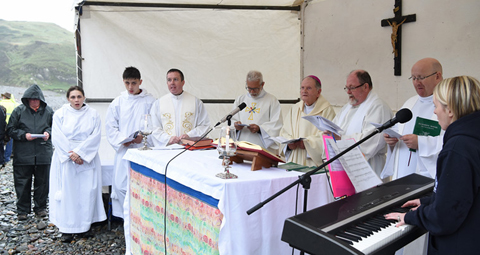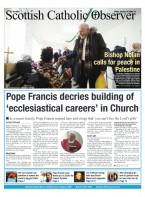July 14 | ![]() 0 COMMENTS
0 COMMENTS ![]() print
print

Following the footsteps of ancient pilgrims
With the summer holidays underway, AMANDA CONNELLY finds an exciting project in the south of Scotland — By Amanda Connelly
AS THE summer months roll in, many are booking up trips and jet-setting off in favour of sunnier climes—a bid to unwind and relax, taking some much-needed rest from the stresses of everyday life.
Yet while some are away to explore foreign lands, one pilgrimage group and trust are combining their efforts to offer their own spiritual retreat from the modern world, and the added opportunity of exploring more of Scotland’s rich pilgrim past.
Following in the steps of saints, monks and monarchs, people from Scotland and beyond are being invited to take part in the Whithorn Way: a long-distance walking route with breathtaking views and a fascinating insight into the Christian pilgrimage route from Glasgow to Whithorn.
Julia Muir-Watt of the Whithorn Trust said: “The route from Glasgow to Whithorn is obviously 1,500 years old, and we wanted to publicise it as a walking route. There’s an enthusiastic interdenominational group up in Glasgow and Paisley called the Whithorn Way Steering Group, and some of them come from Paisley Abbey and St Mirin’s Cathedral.
“Most of them are walkers and most are members of a church of one description or another.”
Following the successful completion of the 143-mile walk by a group of pilgrims to commemorate the 850th anniversary of Paisley Abbey, a desire to leave a legacy of the much-trod paths and to encourage others to take part saw the Whithorn Way ancient pilgrimage route reborn.
Having secured funding from Dumfries and Galloway Council and the Heritage Lottery Fund, as well as a number of smaller trusts, the Whithorn Way is offering people the chance for informative and reflective walks, with a host of new updates on their way.
Upon hearing of the Whithorn Way group’s desire to publicise the route, the Whithorn Trust were delighted to get involved.
The trust was set up in 1986 to explore the history and archaeology of Whithorn and look at the role in played in Christianity’s development in Scotland. It is made-up of representatives from the Catholic Church, the Church of Scotland, the Scottish Episcopal Church, the local business community and experts in Early Christian and medieval archaeology, history and architecture.
Ms Muir-Watt explained: “We thought we would help them by creating a marketing project.
“We are hiring a camera crew who will operate a drone-mounted camera, which they will fly over major monuments and fly down the Way and create a marketing film.”
Using state-of-the-art filming technology will allow walkers to access short videos of each section of the walk and illustrate the landscape. 3D models will also be used to recreate some of the ruins of abbeys located throughout the walk, digitally restoring them to their former glory.
It is also hoped that local churches, shops and villages will have screens displaying the relevant video to the section of the route on which they are located, highlighting this to walkers.
The route is split into around 12 sections, that each range from between nine to 15 miles long, with an individual film planned for each section.
Other visual aids are also on the cards for pilgrims, including informative guidebooks, and a fold-out map with a pilgrim passport at the back that individuals can have stamped at various pitt-stops along the way. There will also be a certificate pilgrims can receive once they arrive at Whithorn, ‘just as they do at the Santiago de Compostela, to show you’ve completed the Whithorn Way,’ explained Ms Muir-Watt.
“Although it’s about spirituality, it’s also about supporting the local community.”
It is also hoped that the local town hall will be upgraded to accommodate pilgrims in the near future and benefit the local community, as well as to redesign its museum.
While the route benefits local communities and businesses, it also holds a significantly special value for those taking part on the walk.
“People want the isolation, but they also want the connectedness,” Ms Muir-Watt said.
The historic and beautiful nature of the Whithorn Way is the perfect means by which individuals can do this.
“St Ninian’s Cave is a very historic site for pilgrims. We know that the graffiti on the wall of the cave and the crosses carved by pilgrims dates to the eighth century, so we’re talking 13 centuries of pilgrimages to the cave. I think when you link up all the important heritage along the route, you realise how pilgrimage has really shaped the routes through Scotland that we still use, and how they still shape our history and heritage.
“When we have finally linked it all, you will see we are really still living in a pilgrimage landscape, it’s just that we’re not always aware of it.”
The route will also receive some publicity from acclaimed writers this year, after it was revealed that the Wigtown Book Festival in autumn has decided that for its opening evening, writers and bloggers will each chart different sections of the Whithorn Way.
The journey itself has been described as ‘transformative,’ and Ms Muir-Watt hopes it will be appreciated by those from a Faith background.
“I think that the journey has potential for people looking to get away from it all or that are on a Faith journey,” she said. “I think they will find on the route so much that’s inspiring, just to feel that you are in the footsteps of people who have been coming to Whithorn for 1,600 years.
“It’s got to be quite spine-tingling to feel that you’re continuing this great tradition, and I do think that coming into a remote and quieter place is a way of getting away from the busyness of the modern world and Whithorn still has that; it’s still a very special place.”










